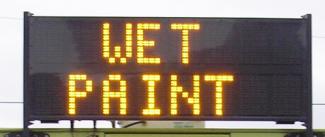Striping
Basic information about annual roadway re-striping work, and how you can help.

Every year, our maintenance crews spend the dryer summer months re-striping thousands of miles of highway around the state. This work is necessary to keep striping visible and reflective at night, as it does wear out over time.
Highway paint is special in that it has tiny little glass beads mixed into it, which is what makes it reflective at night. Similar methods are used for highway signs and license plates. When the beads are hit by headlights, they reflect some of the light back towards the driver, making the paint more visible. The glass beads are made from 100% recycled glass.
Re-striping work is seasonal, as the roadway must be dry and at least 50 degrees to apply the paint. Fortunately, the paint is quick drying, and will be dry in anywhere from 30 seconds to five minutes, depending on conditions at the time of application. Striping season typically runs from the beginning of April to the end of October.
How you can help
We know that re-striping is an inconvenience to drivers while we are doing it, but we need your help to get it done as quickly and effectively as possible:
- Watch for "wet paint" warning signs and warning trucks.
- Listen and look for traffic reports with information about where and when striping crews will be working.
- Don't drive across the wet paint. We normally have a follower vehicle that will give you an idea of where the paint is still wet.
- Keep the distance from the paint truck (or follower vehicle) marked on the sign. This helps to both avoid driving through wet paint and reduce the risk of paint getting on your vehicle.
We do our best to warn drivers about wet paint and keep them out of it. Driving through the wet paint results in the paint sticking to your tire(s) instead of the road, including the reflective glass beads, making the striping less effective and a mess on both the road and your tire. Driving through the wet paint or too close to the paint truck may also result in paint getting on your vehicle.
Should you get paint on your vehicle, you may have about an hour to get the paint sprayed off with a high pressure hose, but sooner is more likely to be successful. The paint is water-based, but it is designed to last under harsh conditions, so once it sets it is nearly impossible to remove. If paint gets on your vehicle when warning signs are present, the state will deny the reimbursement claim.
Slow down – lives are on the line.
In 2023, speeding continued to be a top reason for work zone crashes.
Even one life lost is too many.
Fatal work zone crashes doubled in 2023 - Washington had 10 fatal work zone crashes on state roads.
It's in EVERYONE’S best interest.
95% of people hurt in work zones are drivers, their passengers or passing pedestrians, not just our road crews.
